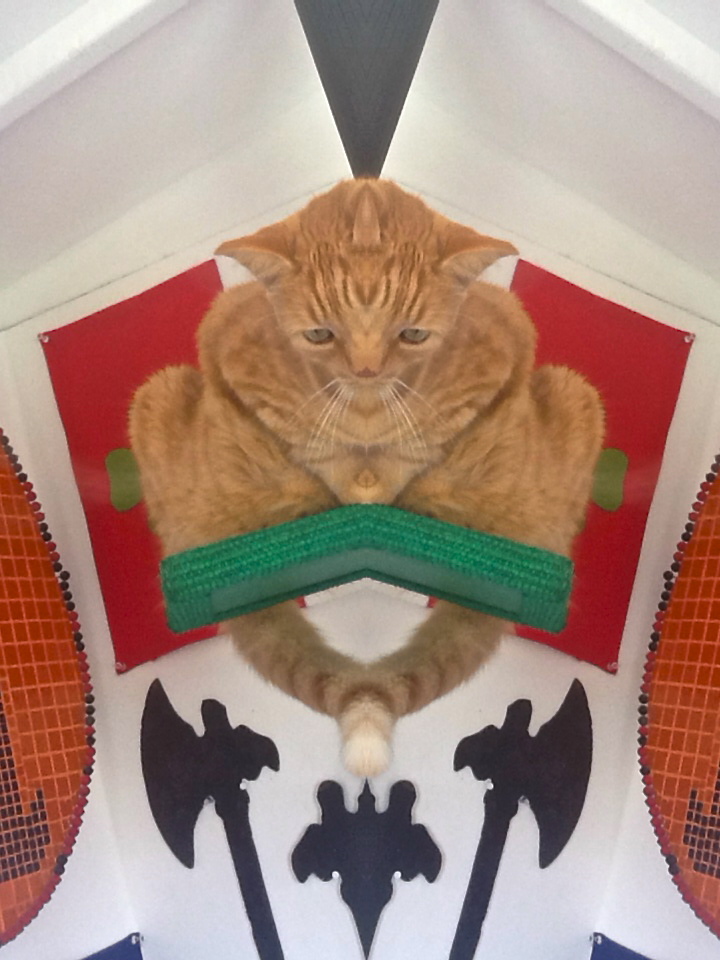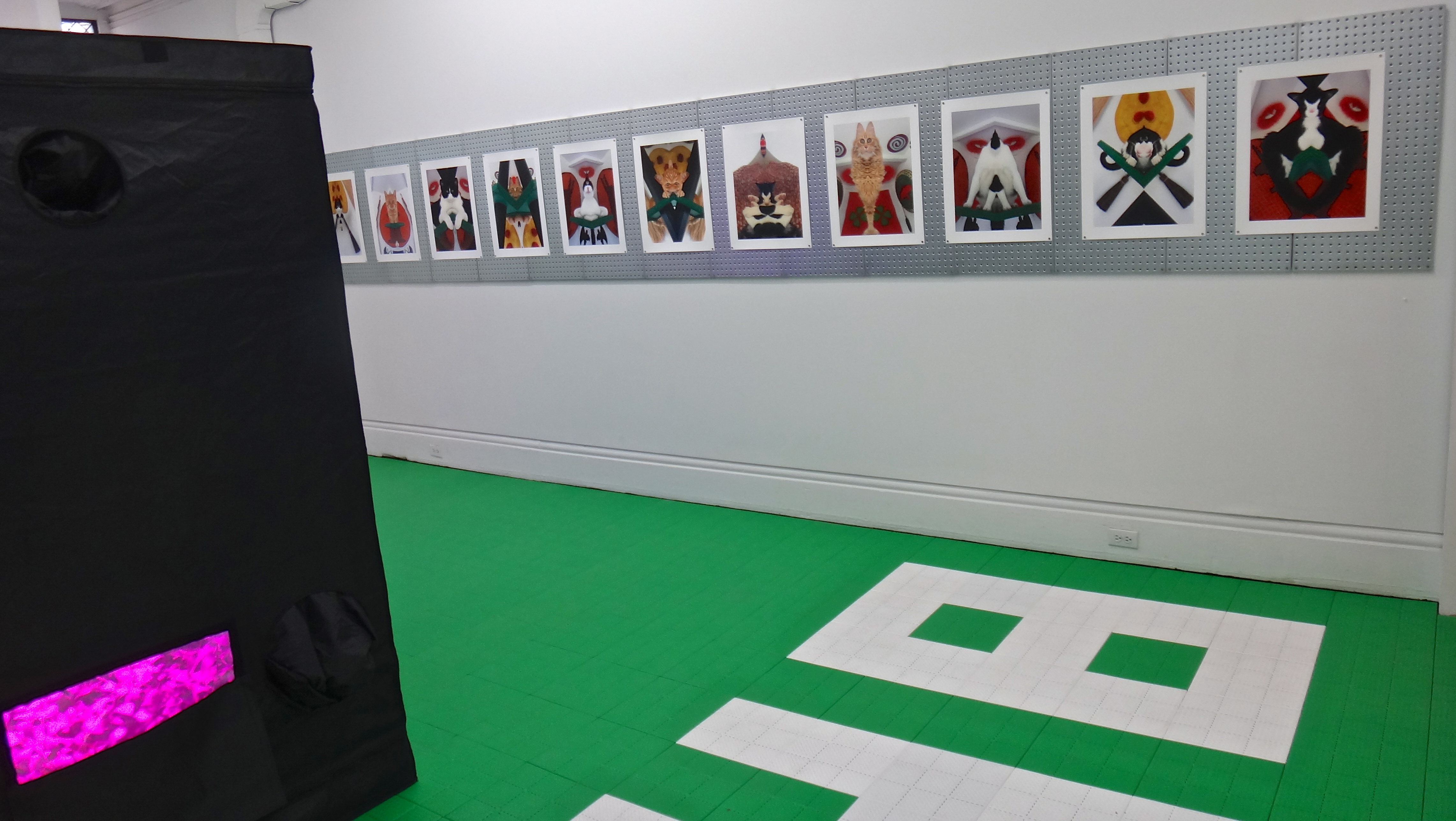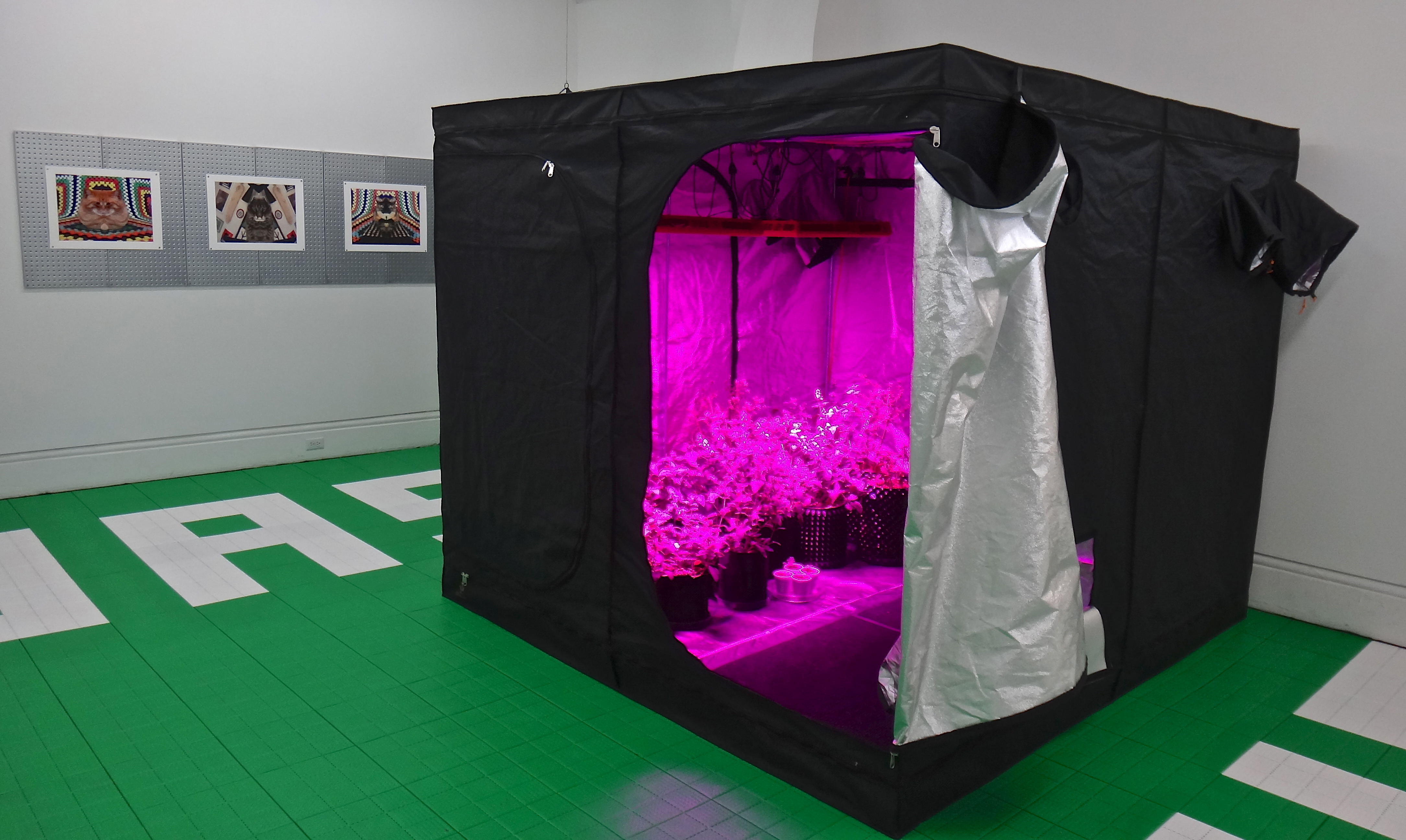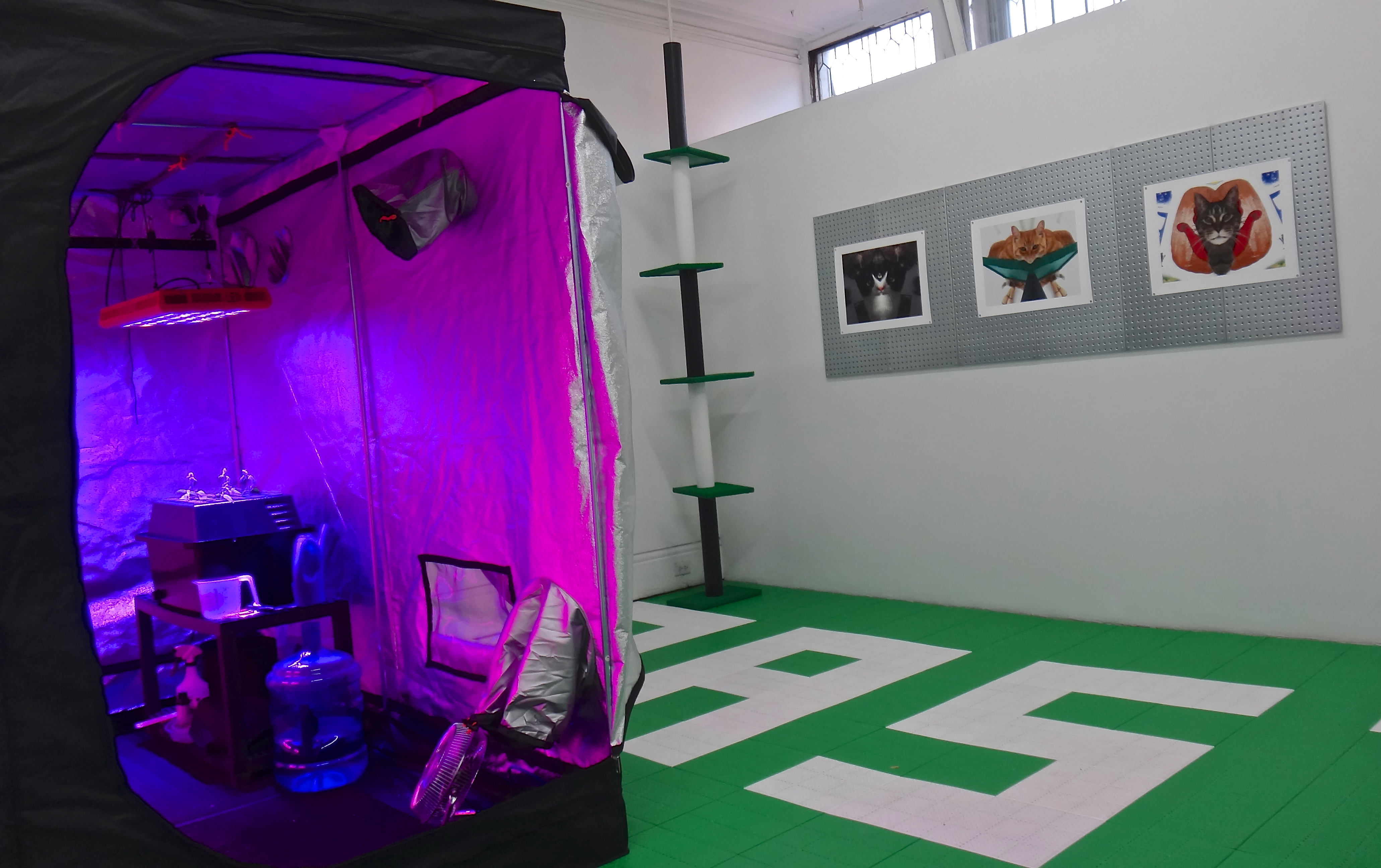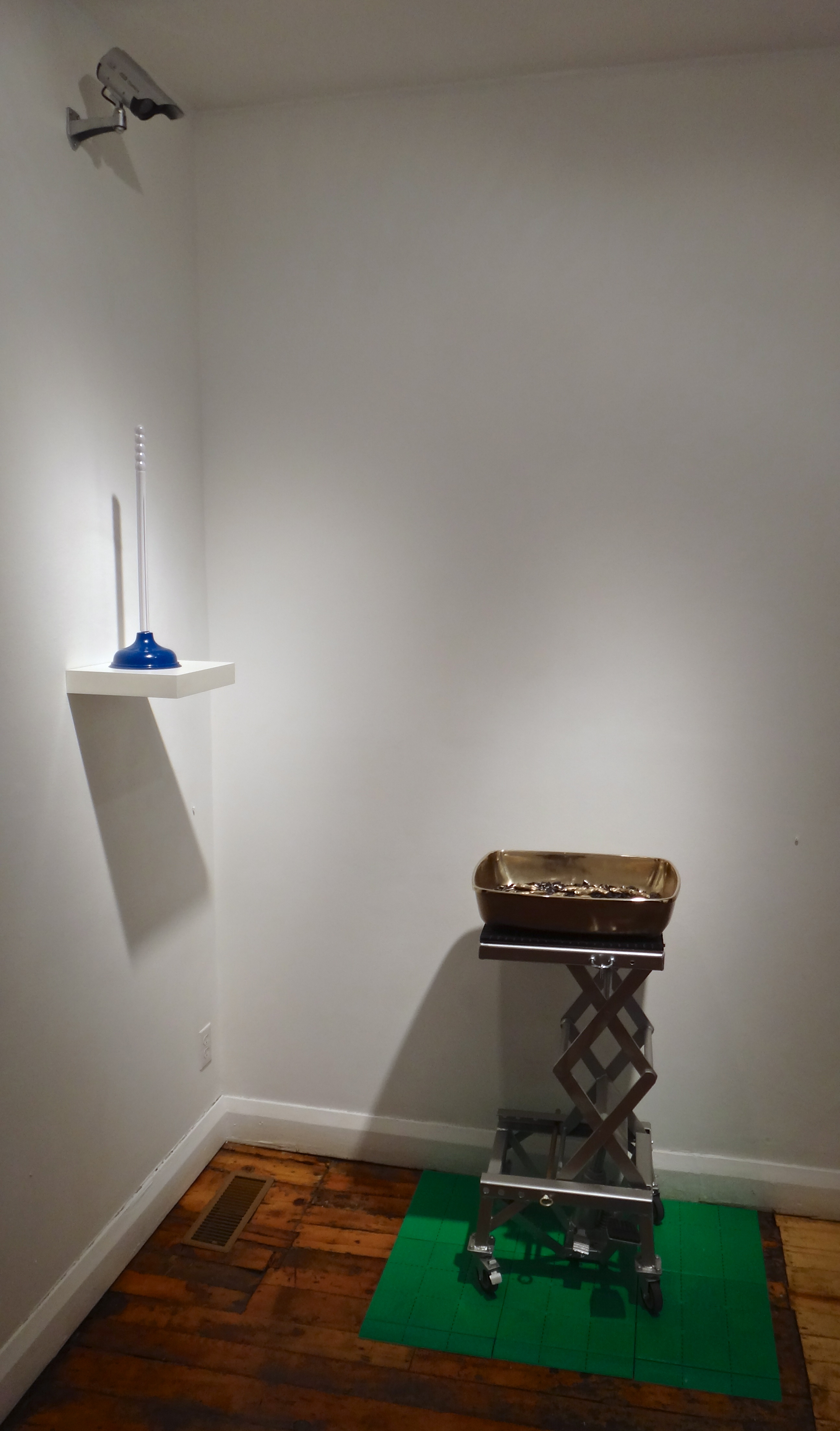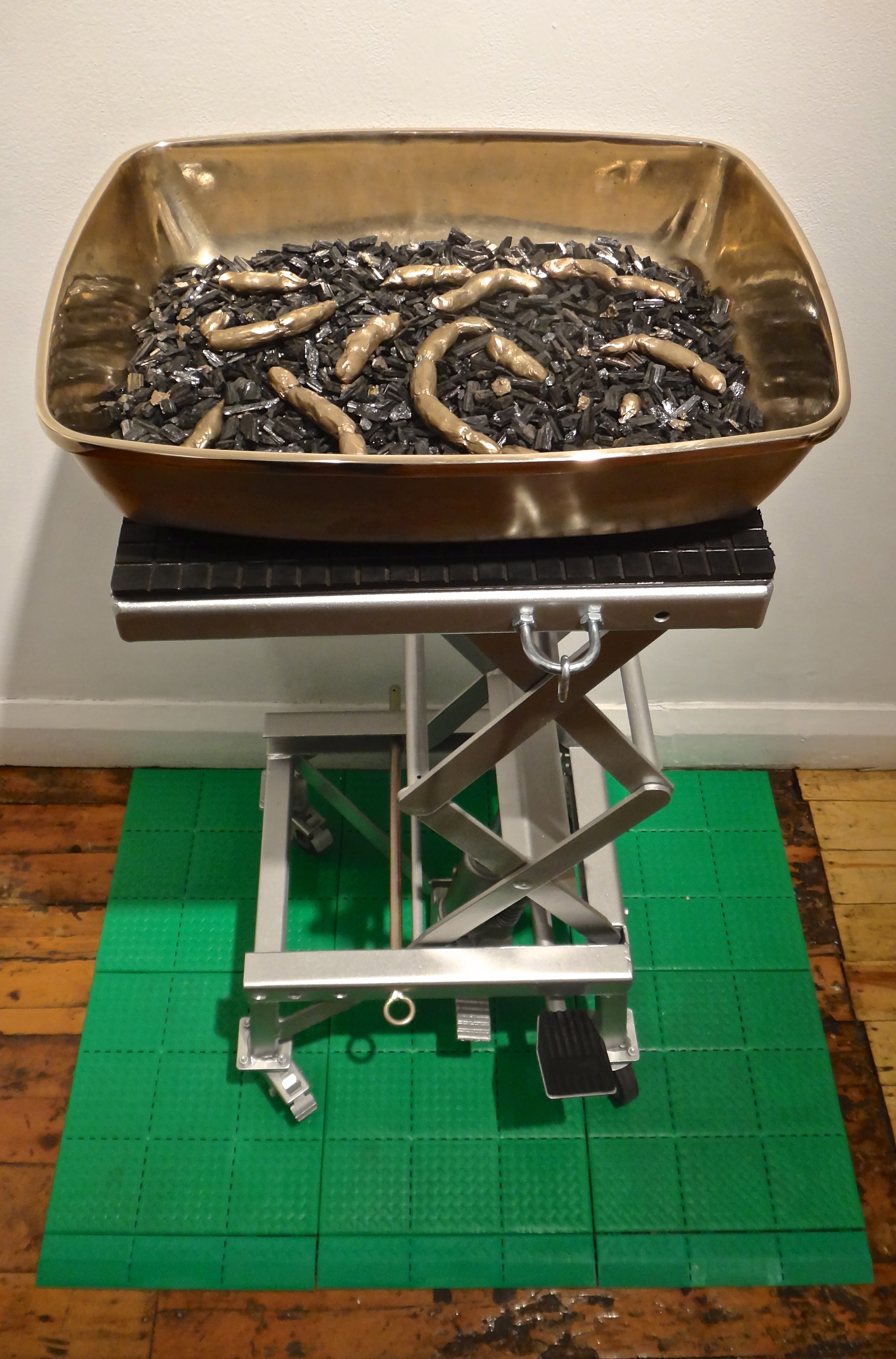Cannibal Nympho Witch
FASTWÜRMS
October 12 - November 10, 2012

Cannibal Nympho Witch
Cannibal Nympho Witch is an exhibition based on an unpublished FASTWURMS science fiction novel of the same name. Started in 1992 and ongoing, Cannibal Nympho Witch the novel is a large complex narrative of imaginative and speculative fiction. Cannibal Nympho Witch is one of several stories, including Donkey@Ninja@ Witch, that serve as a generative source for FASTWURMS visual art projects.
The novel Cannibal Nympho Witch is about a society of transgenetic Witches living in a ‘tranny’ future world they have created after the ecological destruction and total economic collapse of the 21st century.
The story starts with a coven of these futuristic Witches at their volcanic island research complex near Iceland. They use advanced geological energy systems and are adept at biological and bio-technological science. These ‘Dragvandil’ ice and fire Witches are adherents of BAST; they worship the divine feline. They have hybridized with cat genetics and they bond with their transgenetic cat familiars in loving reincarnation rituals and perilous transgalatic and transdimensional voyages.
In the exhibition, Cannibal Nympho Witch, the Bast Box is a sculpture based on the divination and navigation systems of the Dragvandil Witches. Before any trans-voyage, a bronze cat litter box is filled with meteorite fragments and black crystal tourmaline. The BAST navigator casts the ritual bronze cat turds into the meteorite and tourmaline mix to gain insight on a star course by reading the skry patterns.
In the novel, Cannibal Nympho Witch, the Dragvandil Witches revere a sacred grove of catnip that is artificially replicated in all their moon rooms. Various hybrid strains of Nepeta cataria are used by the Witches and their familiars as a divine intoxicant and panaceum.
In the exhibition, Cannibal Nympho Witch, the Catnip tent is a working nomadic catnip grow-op, similar in function to the artificial groves of the Dragvandil Witches. One of the naturalized strains of Nepeta cataria in the Catnip tent is a direct descendant from the plants brought to Canada by the first settlers from Europe (catnip was a standard remedy in the pioneer herbal pharmacopeia)
The Catnip tent is also an accurate front line report from the contemporary war on drugs. All the materials and grow systems of the ‘Catnip tent’ installation were sourced from the online medical cannabis community and purchased from internet suppliers.
The Nix portraits are giclee prints of a crew of familiars captured in camera using an i-Pad. In the novel, Cannibal Nympho Witch, Nix are energetic unpredictable shape shifters. They pop up in transdimensional space, often indicating to BAST navigators a distant gamma ray source.
The Game of Cat and Dragon, is a project based on the famous Cordwainer Smith short story, The Game of Rat and Dragon, 1955.
FASTWURMS have inserted into the original story, and the layout from Galaxy magazine, new illustrations and prose descriptions of their own cat partners. The giclee prints of the text and illustrations are paired with a game set of five quartz platonic solids and one ameythst octahedron. These mineral ‘dice’ are based on a game system used by the Dragvandil Witches.
For the futuristic Dragvandil Witches, the lessons of the global collapse of the 21st century can be reduced to:
1. shun the pathological dissociation of instrumental reason.
2. remember the terrible consequences of unconstrained growth and the total commodification of the natural world.
By contrast, the ethos of the Dragvandil Witches is a total and polymorphous identification with the natural world and a passion to connect with all life forms in the universe.
FASTWURMS September 12, 2012
Formed in 1979 by Kim Kozzi and Dai Skuse, FASTWURMS is the trademark and joint authorship of these Toronto/Creemore- based multidisciplinary artists whose artwork melds high and popular cultures, bent identity politics, social exchange and a Witch positive DIY cinematic sensibility.
FASTWURMS has exhibited and created public commissions and installations, performance, video and film projects, across Canada and in the United States, Europe, Brazil, Korea, and Japan.
Exhibitions include Soylent Orange and Red of Tooth and Kaw at the 27th Biennale de Sao Paulo, Brazil. Donky@Ninja@Witch at the Art Gallery of York University, Toronto, the Contemporary Art Galley, Vancouver, and Plug In ICI, Winnipeg.
FASTWURMS also recently exhibited Krummi Krunkar: Tarot+Tattoo in Reykjavik, Iceland, as part of the SEQUENCES Festival. House of Bast in Sligo, Ireland, and Bast is Best at The Power Plant. Their site sculpture Owl is currently installed on the roof of the Albright Knox as part of the Beyond/In, Western NY exhibition, Buffalo.
Feline Witchcraft
The "promiscuous occultism" of FASTWÜRMS
by Sholem Krishtalka, for the Toronto Standard
Paul Petro Contemporary Art is replete with cats. It has been taken over, turned into a shrine of sorts. Not actual cats, of course (when I explained this to an excited acquaintance, she was mildly disappointed that she wasn’t walking into a petting zoo) – but images of cats and offerings to cats. This is all courtesy of the FASTWÜRMS, whose latest show, Cannibal Nympho Witch, has just opened at the gallery.
Why the FASTWÜRMS are not yet spoken of in the same terms as the unquestioned greats of contemporary Canadian art – Geoffrey Farmer, Jeff Wall, Janet Cardiff, et al – is utterly beyond me. Their work, as it has evolved over decades, spans sculpture, painting, printmaking, video, and performance. They are funny and puckish, but nevertheless profoundly in earnest and wildly ambitious; the work is propelled by an immense generosity of spirit. Taken all together, it represents the construction of an entire cohesive universe, a point of view that is consistently rigorous, engaged and engaging.
The FASTWÜRMS are, at their core, an artistic duo that live in rural Ontario. Their practice has come to include a vast number of collaborators, assistants and co-conspirators, human and otherwise; but Dai Skuse and Kim Kozzi remain at the centre of it all. They identify as witches, and the promiscuous universe of the occult – which includes, but has not been limited to, astrology, mineralogy, tarot, polytheistic paganism, religious apocrypha – has been a fecund and dominant metaphor in their work for some time now. For the FASTWÜRMS, it is a method of community-building and an ontology; a means interacting with their fellow humans and the natural world. At its broadest, the FASTWÜRMS’ witchcraft is an ethos of conscientious existence.
Animals have always featured in their work, especially those associated with witches: spiders, frogs, snakes, mice, bats, owls, donkeys, unicorns and, of course, cats. Their rural compound-cum-studio is crawling with barn cats, all of whom have been consistent recurring motifs, or more accurately, characters and collaborators in their work. We come to know the FASTWÜRMS cats (past and present) – Spoticus, Ludacris, Dragon Wagon, Taalon, Rustler Crowbar, Pusterniks – like we come to know Cezanne’s Mont St Victoire, or Gustav Klimt’s Emilie Flöge or Alex Katz’s wife Ada. They are artistic personae, whose features and bearings have been rendered mythic by their translation into art.
So it is the FASTWÜRMS cats’ images that ring the walls of the front gallery. Of course, these are not straightforward portraits: the photos were taken on an IPad, and run through various mirroring filters, and so their faces (or their rear ends) are arranged in strange symmetries: a kaleidoscopic netting of stripes and fur and whiskers and paws. Some of them have three eyes, some only have one; multi-eared and -limbed and -tailed, their likenesses assume a psychedelic otherness, like strange feline animas.
In the centre of the room, the ‘WÜRMS have installed a black-light catnip grow-op. The block letters on the plastic-tiled floor read “BAST” – the ancient Egyptian goddess of cats. By the gallery desk, there is a bronze cat tray, filled with litter made of minerals and meteorite fragments, that houses hand-formed bronze turds. It’s an amusing image, but ruminate on that awhile. Earth and heaven are mulched together as a sacramental bedding for alchemically transmuted turd. And dung worship is nothing new: the ancient Egyptians considered the rolled dung of the scarab beetle as a sacred metaphor for Ra, the sun god.
The FASTWÜRMS have their own particular mythology surrounding this installation, and there is more going on here than a trip into the arcane. On a side wall, four photographs are juxtaposed: two “missing cat” posters (in Icelandic) sit atop two found photographs related to the Pussy Riot protest campaign. The cheeky linguistic affinity – rioting pussies with divine cats – all of a sudden lends a sharp political edge to the arcana. (This, by the way is an emblematic FASTWÜRMS trope: the wide embrace of other artists into their inclusive coven).
The Pussy Riot girls become, with the ‘WÜRMS, co-priestesses of this cat shrine, and the polytheistic feline principle assumes the dimension of an endangered anti-authoritarian engagement, extending its claws into the legalization of marijuana, the proliferation of free-speech, feminist activism, and the attempted suppression of this by a fearsome patriarchy. There is one last sculpture in the gallery’s backyard: an ersatz unicorn bomb; a gas tank strapped to a huge unicorn horn, connected to a kitchen timer and a wad of plastic explosive (in reality, the fuse is a pipe cleaner, and the wad of plastic explosive is likely modeling clay, but I’ll leave such petty interpretive details to slaves of patriarchal monotheism). I like to think of this as a sigil of witchy terrorism: that, at the appointed time, when the planets are in their proper alignment, the horn will rocket skyward, and explode its beneficent magic over all of us.
Cannibal Nympho Witch continues at Paul Petro Contemporary Art until November 10.
______
Sholem Krishtalka is the Toronto Standard’s art critic.








